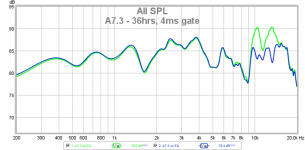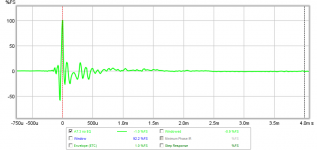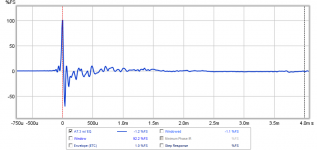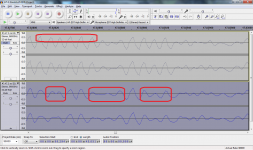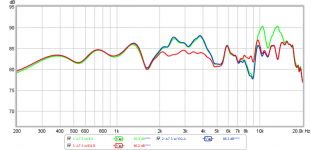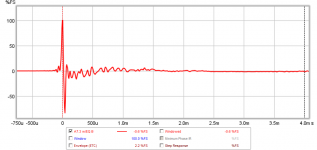I posit that the so-called DDR (Downward Dynamic Range) term, which is promoted as a desirable property of certain drivers for their ability to bring out low level detail, is nothing more than the manifestation of enhanced audibility of transient peaks and other high frequency content through the elongated temporal persistence provided by a ringing-like decay resulting from a large amplitude resonance peak(s) at higher frequencies. This Resonance Enhanced Selective Amplification (RESA) of micro-detail and HF content that is normally at a lower level is what I think people are calling DDR.
The test setup looks like this (similar to the system used in this thread http://www.diyaudio.com/forums/full-range/270614-subjective-blind-comparison-3in-5in-full-range-drivers-61.html):
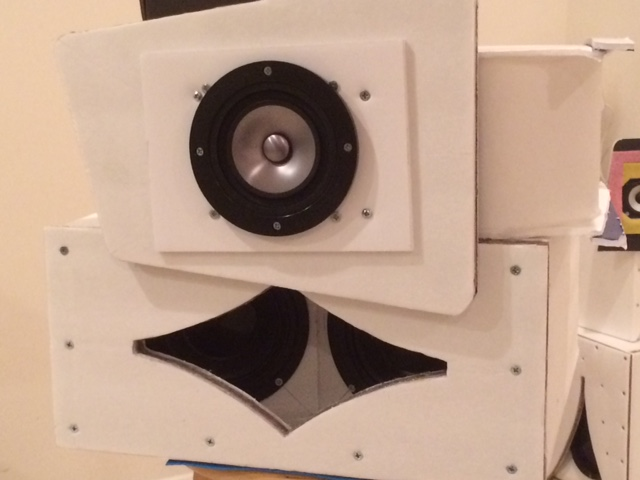
The Alpair 7.3 (aluminum cone) is a driver known for its high level of "DDR" as promoted by certain members in other threads. This driver is now tested in a Nautaloss (sealed short spiral TL) back chamber with a trapezoidal baffle and XKi sub in a FAST configuration with 225Hz XO. Measurements were made with a mic at 0.5m distance with and without EQ to mitigate two resonance peaks at 10 and 13kHz. The frequency response data is then gated at 4ms for presentation. From the data, the A7.3 can be seen to have an approximate +10dB to +12dB set of resonance peaks at circa 10kHz and 13kHz. The plot below shows the frequency response before (green) and after (blue) a parametric EQ (PEQ) is applied to reduce the amplitude of the two peaks (individually). The PEQ and FAST XO are performed using a miniDSP with advanced 2-way plugin and bi-amped using a custom DUG (v0) TPA3116D2 amp. Details of the Nautaloss and XKi enclosures can be found elsewhere. (see http://www.diyaudio.com/forums/full-range/247598-nautaloss-ref-monitor.html and http://www.diyaudio.com/forums/full-range/268524-xki-xs-ab-initio-karlson-6th-order-bandpass-26.html#post4226956)
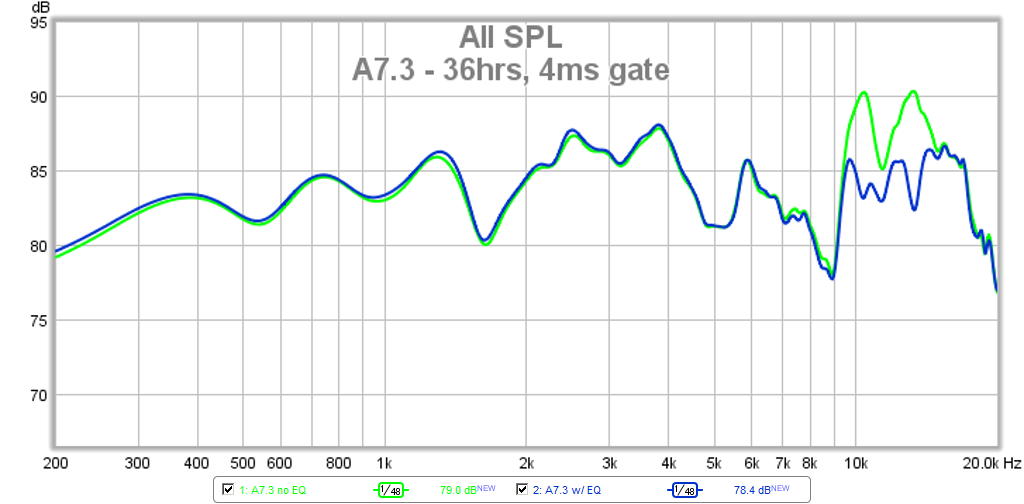
The Impulse Response corresponding to the two curves above show that the non-EQ'd response has a longer duration ringing artifact. There is still a substantial set of broader peaks at circa 2.5kHz and 3.7kHz but those will be left as is for now. Those peaks, nonetheless contribute to the ringing that still remains.
Here is the IR without EQ:
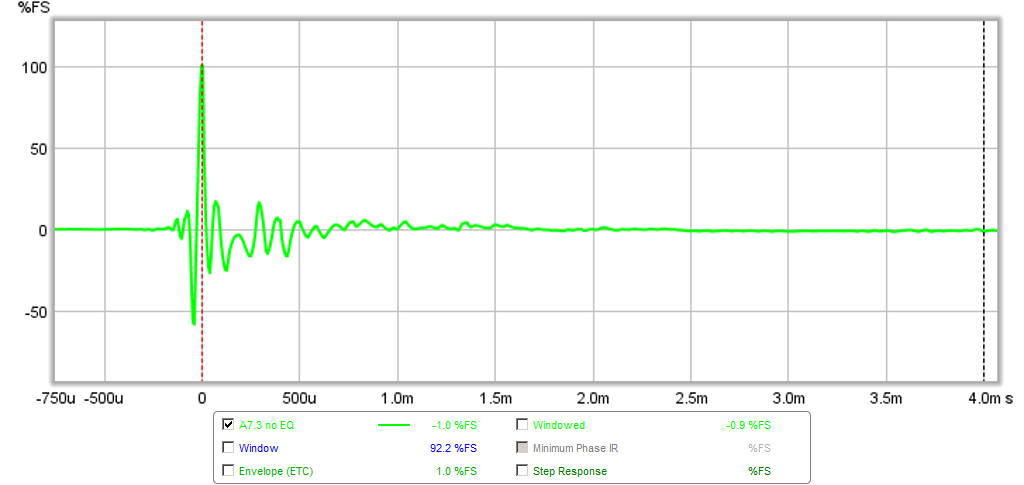
Here is the IR with EQ:
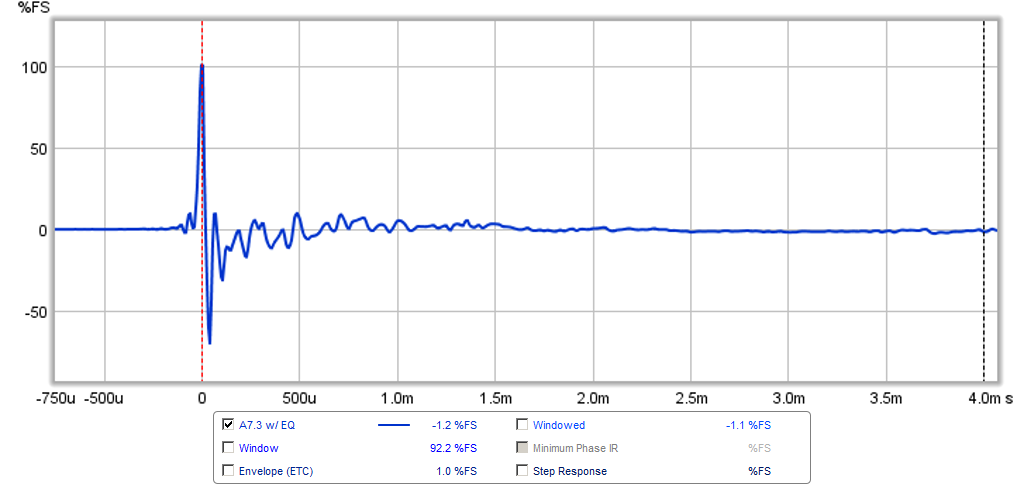
As can be seen, some reduction in the ringing amplitude can be observed and there is still residual ringing left over from the other frequency response anomalies. However, we will test to see what the effect of removing the 10kHz and above peaks does to the sound of the speaker. Even with the HF peaks EQ'd flat, it probably still has a substantial amount of "DDR" effect leftover as a result of the 2.5kHZ and 3.7kHz peaks.
Attached are sound clips with and without EQ applied. They are labeled A and B for now so as to not bias the listener. There is also a third sound clip with the EQ either applied or not (order is not specified) but the change occurs mid-way in the same clip so you can hear the difference in almost an instantaneous A/B comparison. The key to the clips will be provided in a later post, but it will be quite clear - as in clear as (ringing) bell which clip is which. Sound was recorded with a Zoom H4 in raw 96kHz 24bit mode to .wav file and post processed in Audacity with a simple gain adjustment to set peak levels to -0.5dB, and then rendered as a 320kbit mp3 file at 48kHz sample rate in order to fit as an upload. The sound is a stereo recording of the right (mono) channel of the music using the built in XY stereo microphone of the recorder.
To further demonstrate the effect of having large amplitude HF peaks in the response, the detailed temporal signal of the sound is viewed magnified down to the individual sampling points of the 96kHz wav files. Here we can see the differences in the signal with and without EQ as highlighted by the boxes. The non-EQ'd signal has sharp peaks in the sine-wave crests, and enhanced amplitude of HF peaks in certain regions. These are the visible signs of RESA of micro-detail via large amplitude peaks present in a driver with a lot of so-called DDR. The same driver with the peaks removed, show what the intended signal content from the source assuming a flat response speaker is the most accurate representation of the source.
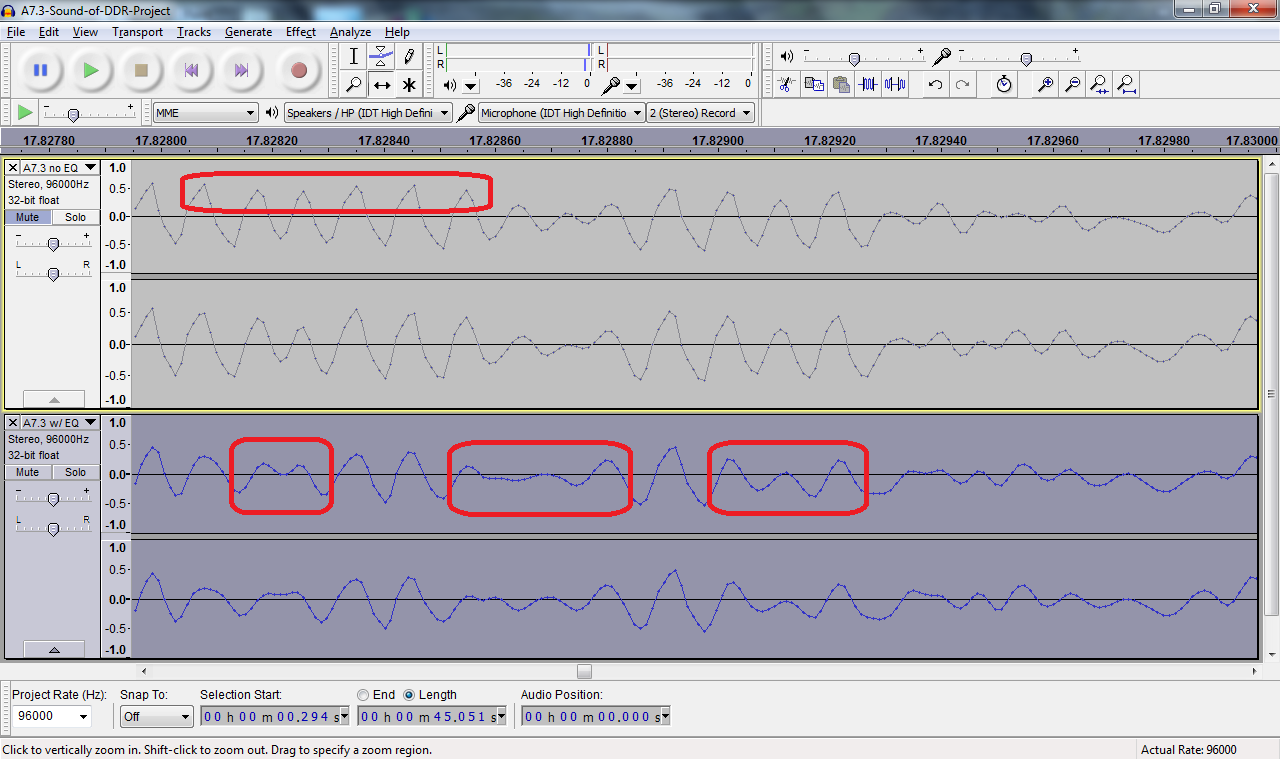
It should be noted that this test was performed using an A7.3 that has undergone about 80 hrs of break-in, although not the full 200 hrs recommended, I saw no significant changes in the measured response or sound since the 36 hr mark.
The enhanced audibility of micro details may be desirable to some listeners, and indeed, sounds very interesting and puts sparkle into many genres of music. However, the point is, that enhanced content was not there to begin with in the source - it is an artifact of the manifestation of RESA, which I think, is a more descriptive name than "DDR" which really doesn't describe the effect.
To be clear, I am not saying that drivers with lots of "DDR" or RESA of micro detail is bad - it just is what it is, but it should not be called a desirable property of high fidelity speakers because it is not reproducing what was intended, but is adding an effect to the signal.
Attached are the sound clips for the A7.3 with and without EQ (random naming convention, and mixed on same track). Change .asc extension to .mp3 in order to listen.
The test setup looks like this (similar to the system used in this thread http://www.diyaudio.com/forums/full-range/270614-subjective-blind-comparison-3in-5in-full-range-drivers-61.html):

The Alpair 7.3 (aluminum cone) is a driver known for its high level of "DDR" as promoted by certain members in other threads. This driver is now tested in a Nautaloss (sealed short spiral TL) back chamber with a trapezoidal baffle and XKi sub in a FAST configuration with 225Hz XO. Measurements were made with a mic at 0.5m distance with and without EQ to mitigate two resonance peaks at 10 and 13kHz. The frequency response data is then gated at 4ms for presentation. From the data, the A7.3 can be seen to have an approximate +10dB to +12dB set of resonance peaks at circa 10kHz and 13kHz. The plot below shows the frequency response before (green) and after (blue) a parametric EQ (PEQ) is applied to reduce the amplitude of the two peaks (individually). The PEQ and FAST XO are performed using a miniDSP with advanced 2-way plugin and bi-amped using a custom DUG (v0) TPA3116D2 amp. Details of the Nautaloss and XKi enclosures can be found elsewhere. (see http://www.diyaudio.com/forums/full-range/247598-nautaloss-ref-monitor.html and http://www.diyaudio.com/forums/full-range/268524-xki-xs-ab-initio-karlson-6th-order-bandpass-26.html#post4226956)

The Impulse Response corresponding to the two curves above show that the non-EQ'd response has a longer duration ringing artifact. There is still a substantial set of broader peaks at circa 2.5kHz and 3.7kHz but those will be left as is for now. Those peaks, nonetheless contribute to the ringing that still remains.
Here is the IR without EQ:

Here is the IR with EQ:

As can be seen, some reduction in the ringing amplitude can be observed and there is still residual ringing left over from the other frequency response anomalies. However, we will test to see what the effect of removing the 10kHz and above peaks does to the sound of the speaker. Even with the HF peaks EQ'd flat, it probably still has a substantial amount of "DDR" effect leftover as a result of the 2.5kHZ and 3.7kHz peaks.
Attached are sound clips with and without EQ applied. They are labeled A and B for now so as to not bias the listener. There is also a third sound clip with the EQ either applied or not (order is not specified) but the change occurs mid-way in the same clip so you can hear the difference in almost an instantaneous A/B comparison. The key to the clips will be provided in a later post, but it will be quite clear - as in clear as (ringing) bell which clip is which. Sound was recorded with a Zoom H4 in raw 96kHz 24bit mode to .wav file and post processed in Audacity with a simple gain adjustment to set peak levels to -0.5dB, and then rendered as a 320kbit mp3 file at 48kHz sample rate in order to fit as an upload. The sound is a stereo recording of the right (mono) channel of the music using the built in XY stereo microphone of the recorder.
To further demonstrate the effect of having large amplitude HF peaks in the response, the detailed temporal signal of the sound is viewed magnified down to the individual sampling points of the 96kHz wav files. Here we can see the differences in the signal with and without EQ as highlighted by the boxes. The non-EQ'd signal has sharp peaks in the sine-wave crests, and enhanced amplitude of HF peaks in certain regions. These are the visible signs of RESA of micro-detail via large amplitude peaks present in a driver with a lot of so-called DDR. The same driver with the peaks removed, show what the intended signal content from the source assuming a flat response speaker is the most accurate representation of the source.

It should be noted that this test was performed using an A7.3 that has undergone about 80 hrs of break-in, although not the full 200 hrs recommended, I saw no significant changes in the measured response or sound since the 36 hr mark.
The enhanced audibility of micro details may be desirable to some listeners, and indeed, sounds very interesting and puts sparkle into many genres of music. However, the point is, that enhanced content was not there to begin with in the source - it is an artifact of the manifestation of RESA, which I think, is a more descriptive name than "DDR" which really doesn't describe the effect.
To be clear, I am not saying that drivers with lots of "DDR" or RESA of micro detail is bad - it just is what it is, but it should not be called a desirable property of high fidelity speakers because it is not reproducing what was intended, but is adding an effect to the signal.
Attached are the sound clips for the A7.3 with and without EQ (random naming convention, and mixed on same track). Change .asc extension to .mp3 in order to listen.
Attachments
Last edited:
Hi,
The naysayers will insist that your barking up the wrong tree,
and that vices cannot be mistaken for apparent "better quality".
The old subjectivist chestnut, some still swear by Lowthers.
DDR is a buzzword to resort to when you don't know
what your talking about but want to appear to.
Suitably undefinable, its always agrees with opinion.
One alleged effect of EnABLing.
rgds, sreten.
The naysayers will insist that your barking up the wrong tree,
and that vices cannot be mistaken for apparent "better quality".
The old subjectivist chestnut, some still swear by Lowthers.
DDR is a buzzword to resort to when you don't know
what your talking about but want to appear to.
Suitably undefinable, its always agrees with opinion.
One alleged effect of EnABLing.
rgds, sreten.
Last edited:
Good work! I appreciate the effort you put in, xrk. Makes this forum interesting.
I don't think that a bumpier, not-flat, objective measurement automatically means something doesn't "sound good" though. I don't think there's an objective way to measure taste, and I think it's a little disrespectful to put people in "good camps" and "bad camps" depending on their particular taste.
Flat or not - if it sounds good, it sounds good...
Ray
I don't think that a bumpier, not-flat, objective measurement automatically means something doesn't "sound good" though. I don't think there's an objective way to measure taste, and I think it's a little disrespectful to put people in "good camps" and "bad camps" depending on their particular taste.
Flat or not - if it sounds good, it sounds good...
Ray
Good work! I appreciate the effort you put in, xrk. Makes this forum interesting.
I don't think that a bumpier, not-flat, objective measurement automatically means something doesn't "sound good" though. I don't think there's an objective way to measure taste, and I think it's a little disrespectful to put people in "good camps" and "bad camps" depending on their particular taste.
Flat or not - if it sounds good, it sounds good...
Ray
I don't disagree that something with a non flat response can sound good - many of my speakers that use the K-aperture are not flat but sound very nice. In fact one of my most popular builds is the mini Karlsonator. It makes up for it by having a wide uniform polar response and rich bass. It also tends to smooth ragged HF peaks. I don't think I was labeling any flat vs non flat camps in my post - so not sure where your comment about disrespect comes from.
Maybe it's just me, but sreten's comment came off a bit disrespectful to differing tastes.
I guess I read it differently. I still haven't seen any actual definition beyond handwaving, and that seems to be Sreten's complaint. May as well talk about 'refulgence.'
I guess I read it differently. I still haven't seen any actual definition beyond handwaving, and that seems to be Sreten's complaint. May as well talk about 'refulgence.'
The alloy cone is kinda shiny...
Certainly more shiny as in reflective under some lighting conditions than, say the blue paper cones, but not so much "radiant" as in generating light, which is how I take the term.
And it's hard not to agree with much of sreten's comments, particularly over a wider context than just the full- range forum
Of course, intellectual agreement won't always trump subjective / emotional bias, " taste", pick any number of non- pergoratives.
And it's hard not to agree with much of sreten's comments, particularly over a wider context than just the full- range forum
Of course, intellectual agreement won't always trump subjective / emotional bias, " taste", pick any number of non- pergoratives.
Last edited:
Hi,
The naysayers will insist that your barking up the wrong tree
Your = you're
I posit that the so-called DDR (Downward Dynamic Range) term, which is promoted as a desirable property of certain drivers for their ability to bring out low level detail, is nothing more than the manifestation of enhanced audibility of transient peaks and other high frequency content through the elongated temporal persistence provided by a ringing-like decay resulting from a large amplitude resonance peak(s) at higher frequencies. This Resonance Enhanced Selective Amplification (RESA) of micro-detail and HF content that is normally at a lower level is what I think people are calling DDR.
It is not.
Sometimes your RESA might bring false detail, but it does not explain DDR as it is a broad spectrum phenomenon.
You are trying to stuff a square peg into a round hole, since you have this false belief that flat FR can tell you everything.
dave
I still haven't seen any actual definition beyond handwaving
DDR is the lower limit of the dynamic range under dynamic conditions.
dave
Change the .asc extension to .mp3
Not a good format for exploring DDR, since the act of converting to MP3 throws out so much information, some of the 1st the stuff you arelooking for.
dave
It is not.
Sometimes your RESA might bring false detail, but it does not explain DDR as it is a broad spectrum phenomenon.
You are trying to stuff a square peg into a round hole, since you have this false belief that flat FR can tell you everything.
dave
You keep saying that I think measurement of frequency response is everything. It is not which is why I look at inpulse response and I provide sound clips. A measurement using the process in REW and other measurement suites provides in addition to FR, impulse response, harmonic distortion, CSD, waterfall spectrum, step response, phase, ... The perception of human hearing to first order is dominated by frequency response.
Show some evidence that the DDR effect is broad spectrum. It's going to be tough to hear a -40dB change to a low freq signal that has no sharp percussive peak.
Last edited:
The sound clips are so convolved with so many other things (and then hammered by conversion to MP3) that they are not very useful for anything.
Yawn... this seems to be the same broken record line you give everytime. Let's see how not useful it is if folks can hear the difference that a 12dB peak at 10 and 13kHz do to the overall music.
Hi,
P10 is never going to agree with the Posit given in the OP.
There is no good reason why he should that it is RESA.
That would be shooting yourself in the foot, bigtime.
DDR does not exist as an objective fact, and any
explanation is plausible for a subjective opinion,
e.g. hysteresis, and high Qms is touted as good.*
It may well be true RESA effects fool a lot of
people a lot of time, as they are notoriously
unreliable in subjective opinions, but DDR
is so waffly it can cover almost anything.
That it exists in drivers as a wideband effect
is also not an objective fact, pure conjecture.
rgds, sreten.
* To be fair I view very low Qms drivers as very suspect.
P10 is never going to agree with the Posit given in the OP.
There is no good reason why he should that it is RESA.
That would be shooting yourself in the foot, bigtime.
DDR does not exist as an objective fact, and any
explanation is plausible for a subjective opinion,
e.g. hysteresis, and high Qms is touted as good.*
It may well be true RESA effects fool a lot of
people a lot of time, as they are notoriously
unreliable in subjective opinions, but DDR
is so waffly it can cover almost anything.
That it exists in drivers as a wideband effect
is also not an objective fact, pure conjecture.
rgds, sreten.
* To be fair I view very low Qms drivers as very suspect.
Last edited:
More EQ'ing of the A7.3
I added two more bands of peak cutting (2.5kHz and 3.7kHz) and added a little to fill the dip near 9kHz (I know, I know, never fill dips, only cut peaks). Here is what the response looks like:
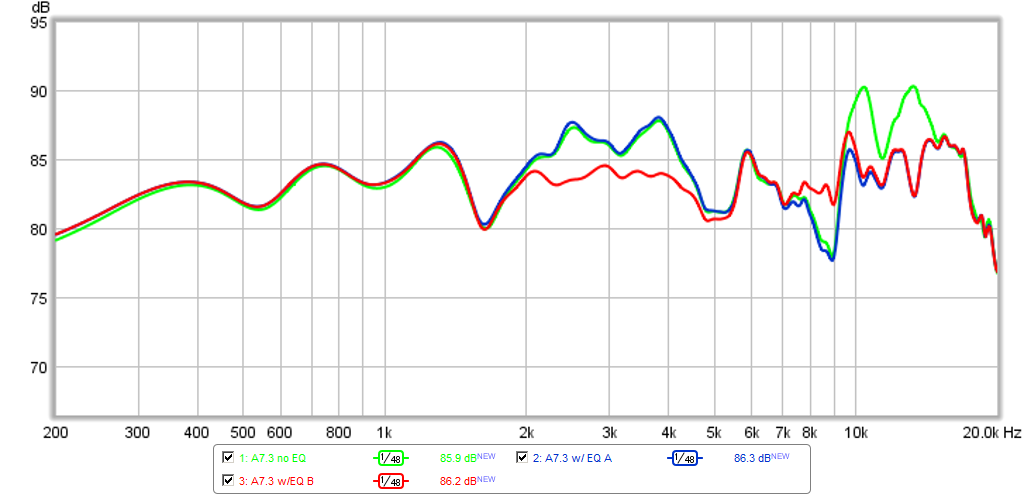
And here is the corresponding Impulse Response - cleaned up quite a bit now:
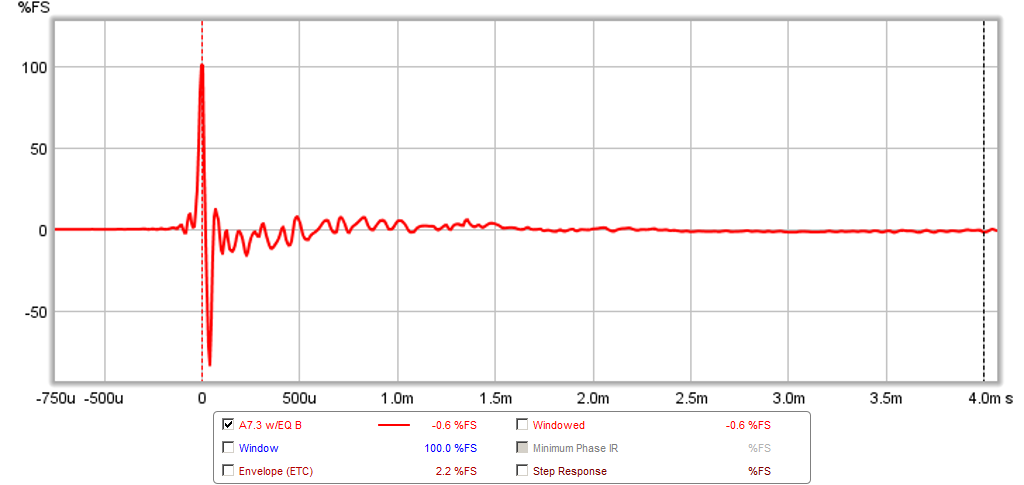
I took a sound clip but it got corrupted so I will have to repeat when I get back to the lab.
I added two more bands of peak cutting (2.5kHz and 3.7kHz) and added a little to fill the dip near 9kHz (I know, I know, never fill dips, only cut peaks). Here is what the response looks like:

And here is the corresponding Impulse Response - cleaned up quite a bit now:

I took a sound clip but it got corrupted so I will have to repeat when I get back to the lab.
Attachments
- Status
- This old topic is closed. If you want to reopen this topic, contact a moderator using the "Report Post" button.
- Home
- Loudspeakers
- Full Range
- Resonance Enhanced Selective Amplification (RESA) - aka DDR
